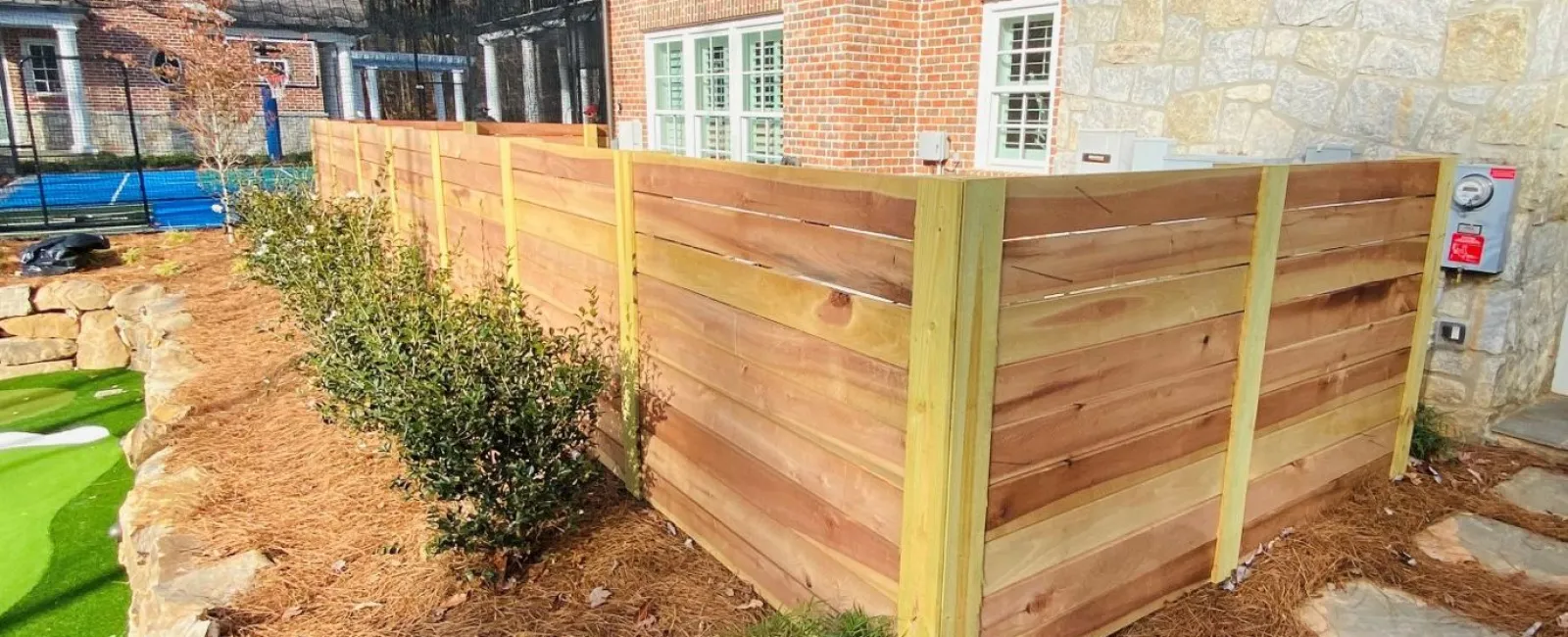A horizontal fence puts a fresh, modern twist on traditional fencing.
When installing a fence, property owners usually have a primary purpose. Maybe they want extra security, more privacy, or to keep pets and children safe in the yard.
However, fencing doesn’t have to be only functional. It can add structure, style, and curb appeal to your property. One of the hottest trends right now is horizontal fencing.
From privacy fences to pool enclosures, installing a horizontal fence can help give your residential or commercial property an aesthetic facelift.
What is a Horizontal Fence?
A horizontal fence has most of the same fencing components as other fence types. These include fence posts, the vertical part anchored into the ground, and fence boards.
However, horizontal fences do not have stringers. Stringers are the horizontal boards between fence posts to which boards are attached. Instead, all the boards run horizontally between posts.
Because of this, horizontal fences usually require posts set no more than six feet apart to minimize sagging.
For wood fences, this reduces lumber usage. Additionally, the board ends face the fence posts rather than being exposed directly to the elements. This helps slow deterioration and cracking.
You can build a horizonal fence from almost any fence material, including wood, metal, and composite. Here are five design ideas to help kickstart your imagination.
Stepped Wood Privacy Horizontal Fence
The wood privacy fence is a staple of residential landscapes. The traditional stockade fences and dog ear pickets have been separating backyards for decades.
However, some property owners desire a more up-to-date look while still needing privacy.
Installing a horizontal privacy fence is an easy way to modernize your property. By placing the boards close together, the fence still provides the same superior privacy as a vertical wood fence.
Additionally, horizontal wooden fences offer more flexibility for sloped yards. You don’t have to worry about lining up the pickets at the top. That makes it easier to prevent gaps at the bottom of the fence when installed on uneven ground.
To prevent sagging and extend the lifespan of a horizontal fence, invest in high quality wood like cedar. Sealing cedar boards will help prevent softwoods from absorbing excess water, which is one of the main causes of sagging.
Aluminum Slat Horizontal Fence

If you’re looking for a low-maintenance horizontal fence design, aluminum slats provide a great option. Aluminum fencing is both durable and easy to care for.
Solid aluminum slat fencing places the slats directly against each other. This design provides excellent privacy but impedes both light and airflow.
On the other hand, spacers allow for different sized gaps between aluminum slats. The gaps can be uniform or staggered, resulting in a truly custom look.
For example, the slats could be placed directly against each other near the ground. This might help to improve privacy or prevent small animals from escaping. Closer to the top, the slats could have wider gaps to allow air to move through them.
Because metal has a sleek, industrial appearance, aluminum horizontal fences are one of the most modern choices.
Shadow Box Horizontal Fence

For small patios, a fence can provide privacy and help create a sense of intimacy. However, some fence styles can feel closed-in, making your outdoor area seem like a cage.
One way to make a fence feel less confining is to prioritize air flow. Shadow box fences have widely spaced boards on either side of the fence, staggered to improve privacy. The gaps allow air to move through the fence.
By placing the boards horizontally, not only does the fence feel more modern, but it also provides greater privacy. If someone were to peer through the gap, their sight would be limited to glimpses of the ground or the sky.
The horizonal boards further allow containers to be attached to the fence, providing space for flowers or an herb garden.
Additionally, it looks good from either side, making it a popular type of fencing when you have nearby neighbors.
Wood and Metal Horizontal Fence

Combining wood and metal fencing materials is a great way to make your modern fence project even more interesting. For example, you can use metal posts or even a full metal frame around the wood boards or slats.
The rough wood and smooth metal provide visual contrast. While wood is often considered earthy or rustic, metal can have an industrial feel. This earth/urban contrast is a popular part of the modern architecture aesthetic.
Additionally, the wood can be painted or stained to add less or more contrast. By using these two popular fencing materials together, the design options are almost endless.
Use a Horizontal Wood Fence as an Accent

You can build a horizontal fence accent that complements your existing architecture. This patio combines masonry walls with horizontal wood.
The wood fence provides color and texture to an otherwise stark look, adding visual interest. The gaps between the wood slats also allow for greater air flow while helping create privacy.
A key aspect of modern design is the unexpected combination of contrasting elements. This “mixed media” approach is a fantastic way to enliven your outdoor space.
If you’d like more information about horizontal fences or want to schedule installation, contact First Fence of Georgia.


